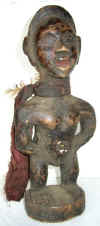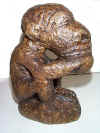 |
 |
TRIBAL AFRICAN ART
TEMNE (ATEMNE, TIMNE)
Sierra Leone
Today,
1,000,000 Temne people, who are related to the Baga, live in small chiefdoms within Sierra
Leone. Ruled by a central chief, they are socially regulated by secret societies such as
the male poro and the female bondo (bundu)
associations. The men of the poro used to take future initiates away; they would
remain absent from their village for several months, sometimes for years, until the time
they underwent the ceremony allowing them to wear the sign of the poro, a hat. Then
they would form a work group and spend a few days in the meeting house before being
“reborn” and given a “bush name.” During
initiation rites related to the latter, young girls were led by the head of the
association, called soko, to a sacred grove by a river. At the head of the
procession, the soko may carry a female figure, which is a representation of an
ideal woman. There the girls learn the secrets of womanhood, and undergo a clitoridectomy.
When the initiates have completed their training, they are presented to the community as
fully mature women. Carved wooden headdresses are danced by leaders of the woman's
association to make manifest the spirits who guide them. A masked spirit is seen as one
embodiment of the mystical power of the bondo.
The nomoli are little soapstone sculptures later reused by the ethnicities of the Atlantic coast who came in contact with the Portuguese in 1550. These statuettes represent a masculine figure. The most typical of the Temne sculptures feature a wide head with a noticeable reduction of the occipital part.
For ceremonies designed to legitimize the authority of certain families, the Temne have a mask, which represents the spirit responsible for protecting the reigning dynasty of each chiefdom. This legitimizes the religious power of the new chief. The mask is only seen in public for the enthroning ceremony of a chief, in which it plays a central role. The masker acts as a kind of go-between through whom the new chief takes possession of the chiefdom. Throughout the last four days of the preparatory stages of the installation process (during which the chief-to-be has been kept in ritual seclusion) the masker goes around “buying” the chiefdom by taking gifts from the chief’s family to various occupational groups. Then, on the fifth day, the masker leads the new chief from the forest into the town to appear in public for the first time. He also leads the celebrations that continue over the next four days. Then he disappears and is not seen again. Numerous wooden and rarely beaten brass masks belonging to men's associations have been documented and collected from the Temne. Still in use today in many Temne chiefdoms, the masks represent the guardian spirit of the ruling clan and bear specific names relating to the dynasty concerned.